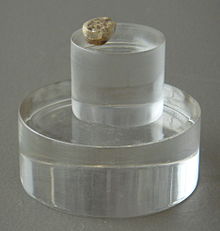Orce man

Mensch von Orce (also: Mann von Orce ) is the name for the roughly palm -sized fragment from the transition from the parietal to the occiput of a fossil skull, which was found in 1982 in the Venta Micena site near the municipality of Orce ( province of Granada , southern Spain ) 1.65 million year old layer was discovered. In 1983 the fossil (archive number VM-0) was interpreted as hominin and assigned to an unspecified species of the genus Homo , which is why it was regarded as the oldest evidence of the genus in Europe at the time. After the fragment had been completely purified, however, this interpretation was revoked in 1987 by two of the three co-authors of the first description from 1983, while the third co-author, Josep Gibert, represented the classification as hominin until his death in 2007. However, Gibert's interpretation was also rejected by numerous other scientists, as features - in particular an initially unrecognizable groin -shaped structure - were discovered on the inside of the fossil , which refer to a large ruminant or a fossil horse foal (genus Equus ).
In 2011, in the Wiley-Blackwell Encyclopedia of Human Evolution published by Bernard Wood for the Venta Micena site, a summary was noted: No confirmed hominin fossils ("No confirmed hominin fossils"). Nonetheless, the find was still being marketed to tourists in 2018 as "the skull of a child who is probably around one and a half million years old, making it the oldest find among all human remains found in Europe."
Dental finds
In 2013, it was reported was in 2002 in the same region as the Fossil VM 0 is the crown of a lower left molar ( ) from the milk teeth have been discovered of a child (VSN BL02-J54-100), which by electron spin resonance to a aged between 1 , 02 and 1.73 million years ago; Paleomagnetic and biochronological data (see reference fossils ) are said to indicate an age of almost 1.4 million years. According to this study, however, the greatest similarities exist between the find and the much younger fossils ATD6-94 from Homo antecessor from the Gran Dolina site (approx. 800,000 years old), Arago 66 from Homo heidelbergensis from the cave of Arago (approx. 450,000 years old ) and a Neanderthal child from the Teschik-Tash cave in Uzbekistan (approx. 70,000 years old).
The discovery of a similarly old tooth fragment from Barranco León site 5 at Orce had already been reported in 1999 (BL5-0), the interpretation of which, however, remained controversial. The dating of the fossil tooth BL02-J54-100 published in 2013 has also been questioned.
Despite these uncertainties, the Archaeological Museum of Orce advertises in tourism that the "Child of Orce" is the oldest human find in Europe.
literature
- Paul Palmqvist: A critical re-evaluation of the evidence for the presence of hominids in Lower Pleistocene times at Venta Micena, Southern Spain. In: Journal of Human Evolution. Volume 33, No. 1, 1997, pp. 83-89, doi: 10.1006 / jhev.1997.0120 , full text
Web links
- The fuss about the cradle of the Europeans. On: derstandard.at of May 7, 2013
Individual evidence
- ^ Josep Gibert et al .: Hominid status of the Orce cranial fragment reasserted. In: Journal of Human Evolution. Volume 34, No. 2, 1998, pp. 203-217, doi: 10.1006 / jhev.1997.0181
- ^ Josep Gibert, Jordi Agusti and Salvador Moyà i Solà : Presencia de Homo sp. en el yacimiento del Pleistoceno inferior de Venta Micena (Orce, Granada). In: Paleontologia y Evolució. Volume 12, pp. 1-9, 1983
- ↑ Jordi Agusti and Salvador Moyà i Solà: Sobre la identidad del fragmento craneal atribuido a Homo sp. en Venta Micena (Orce Granada). In: Estudios geologicos. Volume 43, Nos. 5-6, 1987, pp. 535-538.
- ↑ Josep Gibert et al .: Obliteration study of lambdatic and obelionic region sutures in ruminant, carnivores and hominids. In: Estudios Geológicos. Volume 62, No. 1, 2006, pp. 123-134, full text
- ^ Bienvenido Martínez-Navarro: The skull of Orce: parietal bones or frontal bones? In: Journal of Human Evolution. Volume 43, No. 2, 2002, pp. 265-270, doi: 10.1006 / jhev.2002.0566
- ↑ entry Orce in: H. James Birx (ed.) Encyclopedia of Anthropology. Sage Publications, 2006, ISBN 0-7619-3029-9
- ↑ Bienvenido Martínez-Navarro et al .: Early Pleistocene 'hominid remains' from southern Spain and the taxonomic assignment of the Cueva Victoria phalanx. In: Journal of Human Evolution. Volume 48, No. 5, 2005, pp. 517-523, doi: 10.1016 / j.jhevol.2005.02.003 , full text (PDF)
- ↑ entry Venta Micena in: Wiley-Blackwell Encyclopedia of Human Evolution. Wiley-Blackwell, 2011, ISBN 978-1-4051-5510-6
- ↑ Entry by the municipality of Orce on andalucia.org , accessed on January 2, 2018
- ↑ Isidro Toro-Moyano, Bienvenido Martínez-Navarro, Jordi Agustí, [...] and Paul Palmqvist: The oldest human fossil in Europe, from Orce (Spain). In: Journal of Human Evolution. Volume 65, No. 1, 2013, pp. 1–9, doi: 10.1016 / j.jhevol.2013.01.012 , full text (PDF)
- ^ Josep Gibert et al .: Molar tooth fragment BL5-0: the oldest human remain found in the Plio-Pleistocene of Orce (Granada province, Spain). In: Human Evolution. Volume 14, No. 1-2, 1999, pp. 3-19, doi: 10.1007 / BF02436193
- ↑ Francesc Ribot, Luis Gibert et al .: Two Deciduous Human Molars from the Early Pleistocene Deposits of Barranco León (Orce, Spain). In: Current Anthropology. Volume 56, No. 1, 2015, pp. 134-142, doi: 10.1086 / 679615
- ↑ An infant's milk tooth from Orce is the earliest known human remain in West Europe. (March 2, 2013)
- ↑ Giovann iMuttoni, Giancarlo Scardia and Dennis V. Kent: A critique of evidence for human occupation of Europe older than the Jaramillo subchron (∼1 Ma): Comment on 'The oldest human fossil in Europe from Orce (Spain)' by Toro- Moyano et al. (2013). In: Journal of Human Evolution. Volume 65, No. 6, 2013, pp. 746-749, doi: 10.1016 / j.jhevol.2013.08.005
- ↑ The Child of Orce. In: Granada monumental and cultural tourism, p. 25. Accessed June 11, 2018


